2007 Hyundai H-1 (Grand Starex) warning light
[x] Cancel search: warning lightPage 145 of 284

3
STARTING AND OPERATING
3PRECAUTION FOR EX- HAUST FUMES WHILESTARTING AND DRIVING
D010A01P-GAT
1. Do not breathe exhaust fumes con- taining carbons monoxide when starting or driving. Carbon monox- ide is a colorless, odorless gas and can cause unconsciousness ordeath by asphyxiation.
2. Open all the windows fully and get
the back door closed if you smellexhaust fumes inside the vehicle. Have the cause immediately located and corrected.
3. Check the exhaust system, from time to time, for holes or loose con-nections if you hear a change in theexhaust sound, or if something has hit the exhaust system.
4. Do not race the engine in a garage
or enclosed area any longer than ittakes to start the engine and drive the vehicle in or out. The sealedexhaust fume may make a particu- larly dangerous situation.
!
BEFORE STARTING THE ENGINE
C020A02O-GAT Before you start the engine, you should always:
1. Look around the vehicle to be sure
there are no flat tires, puddles of oil, water or other indications of pos- sible trouble.
2. After entering the car, check to be sure the parking brake is engaged.
3. Check that all windows, and lights are clean.
4. Check that the interior and exterior
mirrors are clean and in position.
5. Check your seat, seatback and headrest to be sure they are in theirproper positions.
6. Lock all the doors.
7. Fasten your seat belt and be sure
that all other occupants have fas- tened theirs.
8. Turn off all lights and accessories
that are not needed. WARNING (DIESEL ENGINE):
To ensure that sufficient vacuum exists within the brake system dur- ing cold weather start-up condi-tions, it is necessary to run the engine at idle for several seconds after starting the engine.
9. When you turn the ignition switch to
"ON", check that all appropriatewarning lights are operating andthat you have sufficient fuel.
10.Check the operation of warning
lights and all bulbs when key is inthe "ON" position.
!WARNING:
Always wear appropriate shoes when operating your vehicle. Unsuitable shoes (high heels, ski boots, etc.) may interfere with yourability to use the brake and accelera- tor pedal, and the clutch (if installed).
Page 152 of 284
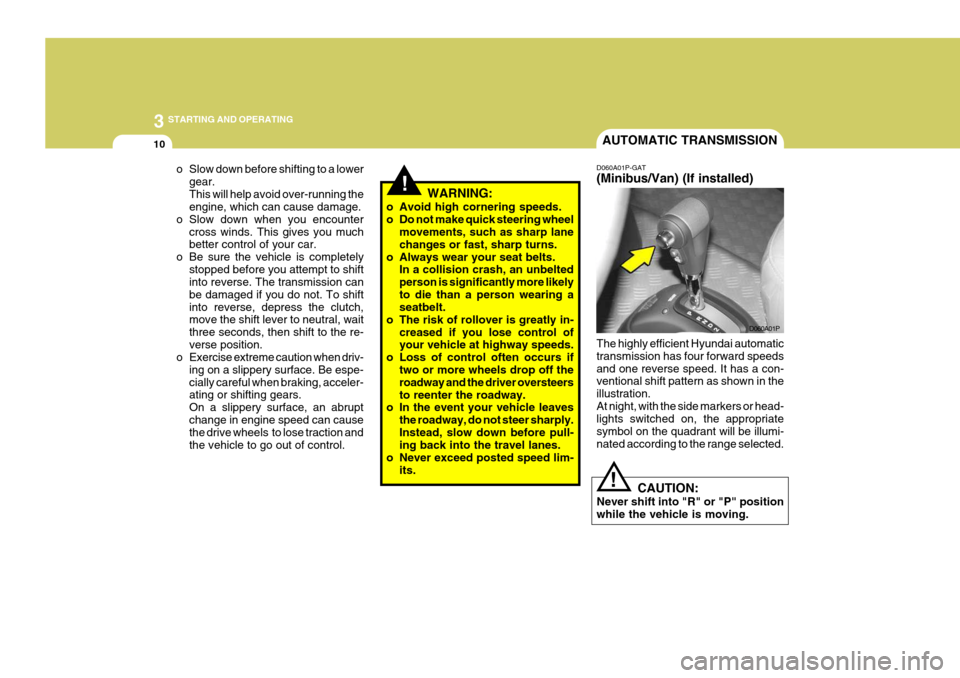
3 STARTING AND OPERATING
10
!
o Slow down before shifting to a lower
gear. This will help avoid over-running the engine, which can cause damage.
o Slow down when you encounter
cross winds. This gives you muchbetter control of your car.
o Be sure the vehicle is completely stopped before you attempt to shiftinto reverse. The transmission can be damaged if you do not. To shiftinto reverse, depress the clutch, move the shift lever to neutral, wait three seconds, then shift to the re-verse position.
o Exercise extreme caution when driv-
ing on a slippery surface. Be espe-cially careful when braking, acceler- ating or shifting gears. On a slippery surface, an abruptchange in engine speed can cause the drive wheels to lose traction and the vehicle to go out of control. WARNING:
o Avoid high cornering speeds.
o Do not make quick steering wheel movements, such as sharp lanechanges or fast, sharp turns.
o Always wear your seat belts. In a collision crash, an unbeltedperson is significantly more likelyto die than a person wearing a seatbelt.
o The risk of rollover is greatly in-
creased if you lose control ofyour vehicle at highway speeds.
o Loss of control often occurs if two or more wheels drop off the roadway and the driver oversteersto reenter the roadway.
o In the event your vehicle leaves
the roadway, do not steer sharply.Instead, slow down before pull- ing back into the travel lanes.
o Never exceed posted speed lim- its.
AUTOMATIC TRANSMISSION
D060A01P-GAT (Minibus/Van) (If installed) The highly efficient Hyundai automatic transmission has four forward speedsand one reverse speed. It has a con- ventional shift pattern as shown in the illustration.At night, with the side markers or head- lights switched on, the appropriate symbol on the quadrant will be illumi-nated according to the range selected. D060A01P
CAUTION:
Never shift into "R" or "P" positionwhile the vehicle is moving.
!
Page 162 of 284

3 STARTING AND OPERATING
20BRAKE SYSTEM
D150A01P-GAT All the parts of the brake system are critical to safety. Have the vehicle ser- viced by an authorized HYUNDAI dealer at regular intervals according tothe service standards.
(1) The service brake is divided into two brake circuits so that when one brake circuit fails, the other is avail- able to stop the vehicle. If this oc-curs, however, the brake pedal must be depressed further than usual; stop driving as soon as possibleand have the brake system ser- viced at the nearest authorized HYUNDAI dealer.
(2) Do not place a thick floor mat around the brake pedal; doing so couldprevent the full pedal stroke thatwould be necessary in an emer- gency. Make sure that the pedal can be operated freely at all times.
(3) If the vehicle is equipped with a brake warning lamp, the lamp willlight up if the brake fluid level isabnormally low.
o Do not grip the inside or spokes of
the steering wheel when driving off-road. The steering wheel could jerk and injure your hands. Always firmly hold the outer steering wheel whenyou are driving off-road.
o Drive at lower speeds in strong
crosswinds. Because of yourvehicle’s high center of gravity, its stability will be affected in cross- winds. Slower speeds ensure bettervehicle control.
o Whenever you drive off-road through
sand, mud or water as deep as thewheel hub, more frequent mainte- nance may be required.
o Do not drive in water if the level is higher than the bottom of the wheelhubs.
o Check your brake condition once you are out of mud or water. Pressthe brake several times as you move slowly until your feel normal brakingforces return.
o Four-wheel driving on flat and nor-
mal roads can result in a severebinding condition when turning the steering wheel. Driving on dry paved road and highway Select 2H(2WD) to drive on dry paved roads. Especially on dry highway, neverselect the 4H or 4L(4WD). Driving on snowy or icy roads Select the 4H or 4L in accordance with the road conditions, and then gradu- ally depress the accelerator pedal for a smooth start. Driving on sandy or muddy roads Select the 4H or 4L and then gradually depress the accelerator pedal for a smooth start. Keep the pressure on the accelerator pedal constant as pos-sible, and drive at low speed. Climbing sharp grades Select the 4L to maximize use the engine torque. Descending sharp grades Select 4L, use the engine brake and descend slowly.
Page 163 of 284
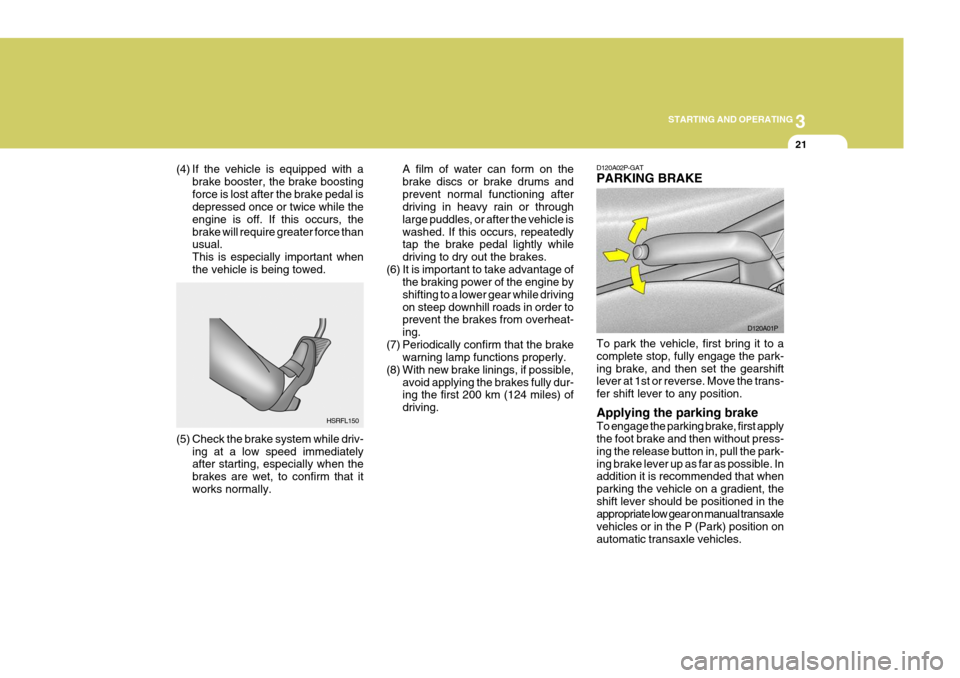
3
STARTING AND OPERATING
21
(4) If the vehicle is equipped with a
brake booster, the brake boosting force is lost after the brake pedal is depressed once or twice while the engine is off. If this occurs, thebrake will require greater force than usual. This is especially important whenthe vehicle is being towed. A film of water can form on thebrake discs or brake drums andprevent normal functioning after driving in heavy rain or through large puddles, or after the vehicle iswashed. If this occurs, repeatedly tap the brake pedal lightly while driving to dry out the brakes.
(6) It is important to take advantage of the braking power of the engine byshifting to a lower gear while drivingon steep downhill roads in order to prevent the brakes from overheat- ing.
(7) Periodically confirm that the brake warning lamp functions properly.
(8) With new brake linings, if possible, avoid applying the brakes fully dur- ing the first 200 km (124 miles) of driving.
HSRFL150
(5) Check the brake system while driv- ing at a low speed immediately after starting, especially when the brakes are wet, to confirm that itworks normally. D120A02P-GAT PARKING BRAKE To park the vehicle, first bring it to a complete stop, fully engage the park-ing brake, and then set the gearshift lever at 1st or reverse. Move the trans- fer shift lever to any position. Applying the parking brake To engage the parking brake, first apply the foot brake and then without press- ing the release button in, pull the park-ing brake lever up as far as possible. In addition it is recommended that when parking the vehicle on a gradient, theshift lever should be positioned in the appropriate low gear on manual transaxle vehicles or in the P (Park) position onautomatic transaxle vehicles.
D120A01P
Page 164 of 284
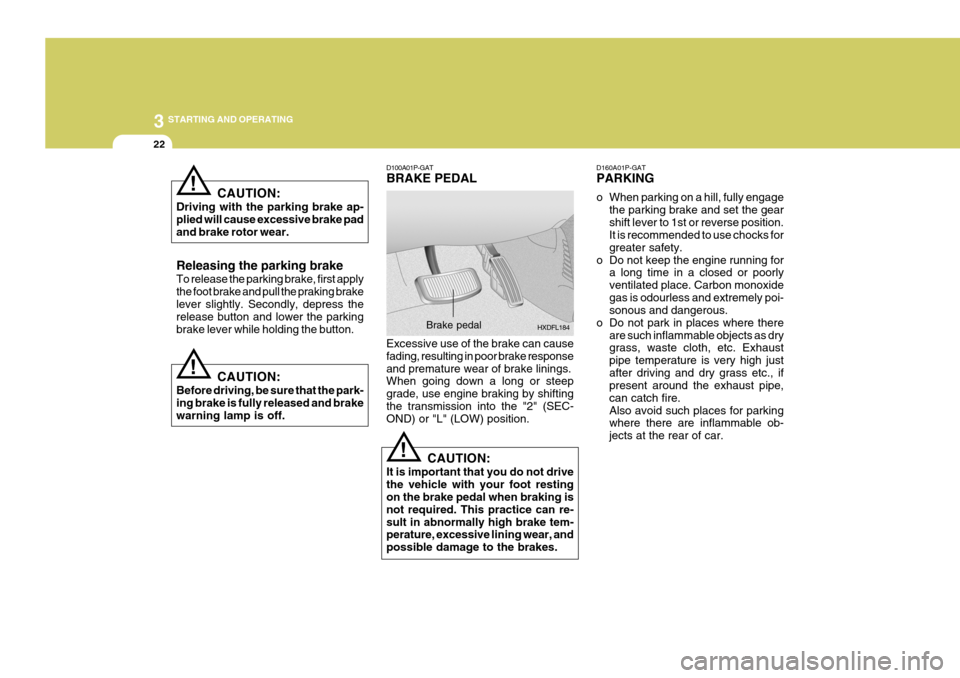
3 STARTING AND OPERATING
22
CAUTION:
Before driving, be sure that the park- ing brake is fully released and brakewarning lamp is off.! D160A01P-GAT PARKING
o When parking on a hill, fully engage
the parking brake and set the gear shift lever to 1st or reverse position. It is recommended to use chocks for greater safety.
o Do not keep the engine running for a long time in a closed or poorlyventilated place. Carbon monoxidegas is odourless and extremely poi- sonous and dangerous.
o Do not park in places where there are such inflammable objects as drygrass, waste cloth, etc. Exhaust pipe temperature is very high justafter driving and dry grass etc., if present around the exhaust pipe, can catch fire.Also avoid such places for parking where there are inflammable ob- jects at the rear of car.
D100A01P-GAT BRAKE PEDAL
CAUTION:
It is important that you do not drive the vehicle with your foot resting on the brake pedal when braking is not required. This practice can re-sult in abnormally high brake tem- perature, excessive lining wear, and possible damage to the brakes.
! HXDFL184
Brake pedal
Excessive use of the brake can cause fading, resulting in poor brake responseand premature wear of brake linings. When going down a long or steep grade, use engine braking by shiftingthe transmission into the "2" (SEC- OND) or "L" (LOW) position.
CAUTION:
Driving with the parking brake ap- plied will cause excessive brake pad and brake rotor wear. Releasing the parking brake To release the parking brake, first apply the foot brake and pull the praking brakelever slightly. Secondly, depress the release button and lower the parking brake lever while holding the button.
!
Page 165 of 284
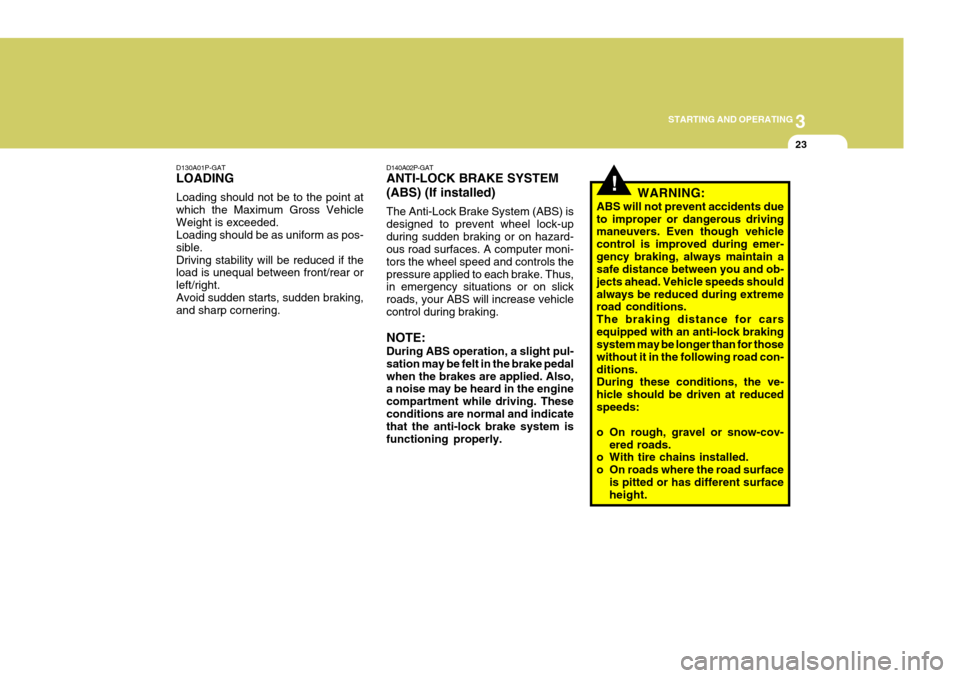
3
STARTING AND OPERATING
23
!
D140A02P-GAT ANTI-LOCK BRAKE SYSTEM (ABS) (If installed) The Anti-Lock Brake System (ABS) is designed to prevent wheel lock-upduring sudden braking or on hazard- ous road surfaces. A computer moni- tors the wheel speed and controls thepressure applied to each brake. Thus, in emergency situations or on slick roads, your ABS will increase vehiclecontrol during braking. NOTE: During ABS operation, a slight pul- sation may be felt in the brake pedalwhen the brakes are applied. Also, a noise may be heard in the engine compartment while driving. Theseconditions are normal and indicate that the anti-lock brake system is functioning properly. WARNING:
ABS will not prevent accidents dueto improper or dangerous driving maneuvers. Even though vehicle control is improved during emer-gency braking, always maintain a safe distance between you and ob- jects ahead. Vehicle speeds shouldalways be reduced during extreme road conditions. The braking distance for carsequipped with an anti-lock braking system may be longer than for those without it in the following road con-ditions. During these conditions, the ve- hicle should be driven at reducedspeeds:
o On rough, gravel or snow-cov- ered roads.
o With tire chains installed.
o On roads where the road surface
is pitted or has different surface height.
D130A01P-GAT LOADING Loading should not be to the point at which the Maximum Gross VehicleWeight is exceeded. Loading should be as uniform as pos- sible.Driving stability will be reduced if the load is unequal between front/rear or left/right.Avoid sudden starts, sudden braking, and sharp cornering.
Page 166 of 284
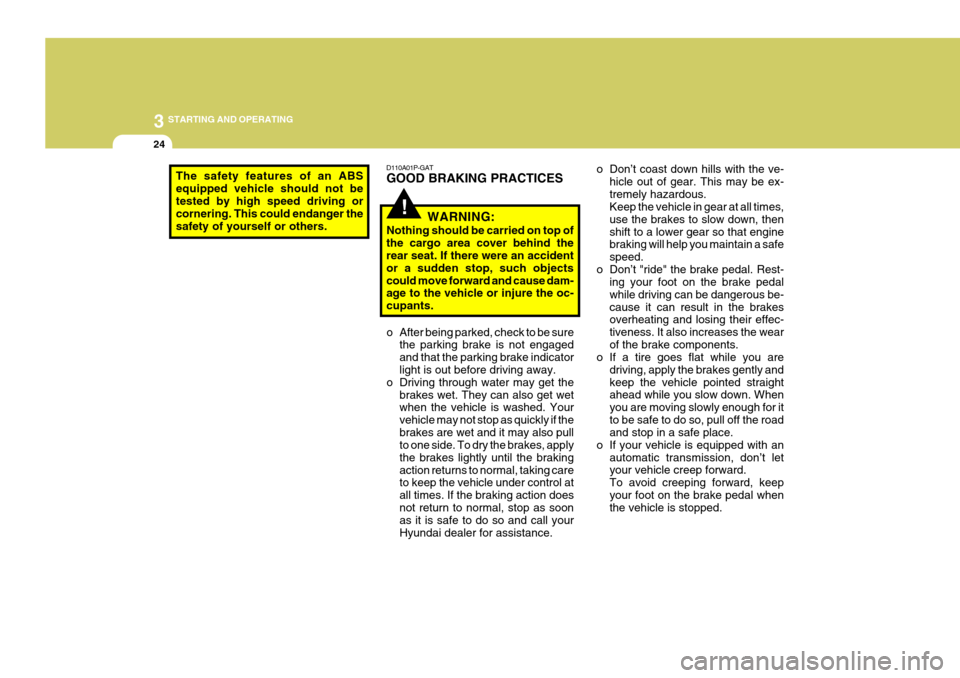
3 STARTING AND OPERATING
24
The safety features of an ABS equipped vehicle should not be tested by high speed driving or cornering. This could endanger thesafety of yourself or others.
!
D110A01P-GAT GOOD BRAKING PRACTICES
WARNING:
Nothing should be carried on top of the cargo area cover behind the rear seat. If there were an accident or a sudden stop, such objectscould move forward and cause dam- age to the vehicle or injure the oc- cupants.
o After being parked, check to be sure the parking brake is not engagedand that the parking brake indicator light is out before driving away.
o Driving through water may get the brakes wet. They can also get wetwhen the vehicle is washed. Your vehicle may not stop as quickly if thebrakes are wet and it may also pull to one side. To dry the brakes, apply the brakes lightly until the brakingaction returns to normal, taking care to keep the vehicle under control at all times. If the braking action doesnot return to normal, stop as soon as it is safe to do so and call your Hyundai dealer for assistance. o Don’t coast down hills with the ve-
hicle out of gear. This may be ex-tremely hazardous. Keep the vehicle in gear at all times, use the brakes to slow down, thenshift to a lower gear so that engine braking will help you maintain a safe speed.
o Don’t "ride" the brake pedal. Rest- ing your foot on the brake pedalwhile driving can be dangerous be-cause it can result in the brakes overheating and losing their effec- tiveness. It also increases the wearof the brake components.
o If a tire goes flat while you are
driving, apply the brakes gently andkeep the vehicle pointed straight ahead while you slow down. When you are moving slowly enough for itto be safe to do so, pull off the road and stop in a safe place.
o If your vehicle is equipped with an automatic transmission, don’t letyour vehicle creep forward. To avoid creeping forward, keepyour foot on the brake pedal when the vehicle is stopped.
Page 168 of 284
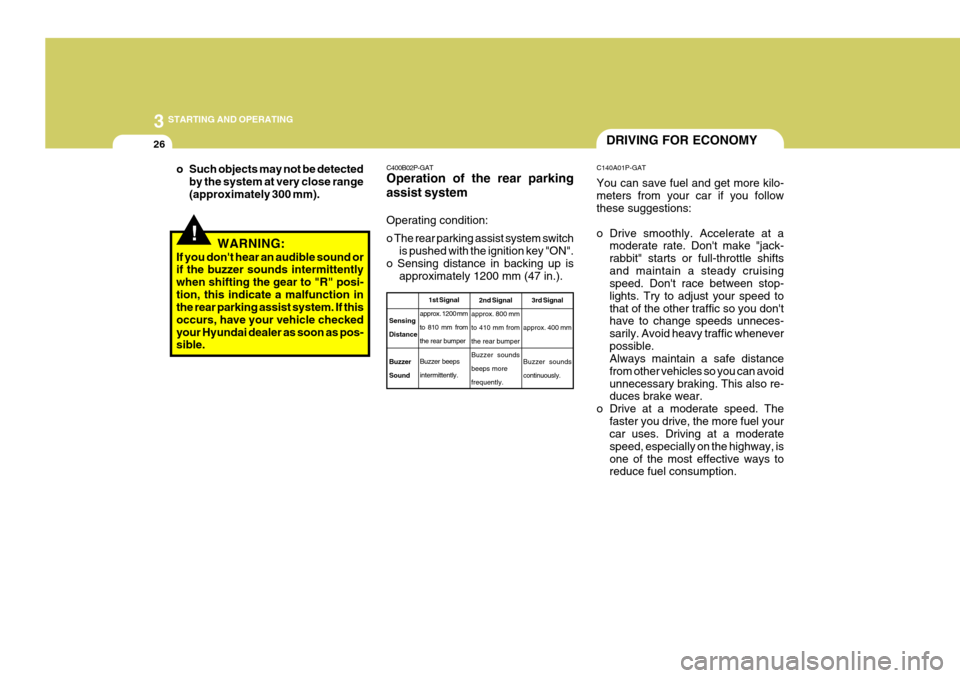
3 STARTING AND OPERATING
26
!
o Such objects may not be detected
by the system at very close range (approximately 300 mm).
WARNING:
If you don't hear an audible sound or if the buzzer sounds intermittently when shifting the gear to "R" posi-tion, this indicate a malfunction in the rear parking assist system. If this occurs, have your vehicle checkedyour Hyundai dealer as soon as pos- sible. C400B02P-GAT Operation of the rear parking assist system Operating condition: o The rear parking assist system switch
is pushed with the ignition key "ON".
o Sensing distance in backing up is approximately 1200 mm (47 in.).
1st Signal
approx. 1200 mm
to 810 mm fromthe rear bumper Buzzer beeps intermittently.
SensingDistance Buzzer Sound 2nd Signal
approx. 800 mmto 410 mm fromthe rear bumperBuzzer soundsbeeps morefrequently. 3rd Signal
approx. 400 mm Buzzer sounds continuously.
DRIVING FOR ECONOMY
C140A01P-GAT You can save fuel and get more kilo- meters from your car if you follow these suggestions:
o Drive smoothly. Accelerate at a moderate rate. Don't make "jack- rabbit" starts or full-throttle shiftsand maintain a steady cruising speed. Don't race between stop- lights. Try to adjust your speed tothat of the other traffic so you don't have to change speeds unneces- sarily. Avoid heavy traffic wheneverpossible. Always maintain a safe distance from other vehicles so you can avoidunnecessary braking. This also re- duces brake wear.
o Drive at a moderate speed. The faster you drive, the more fuel yourcar uses. Driving at a moderate speed, especially on the highway, isone of the most effective ways to reduce fuel consumption.